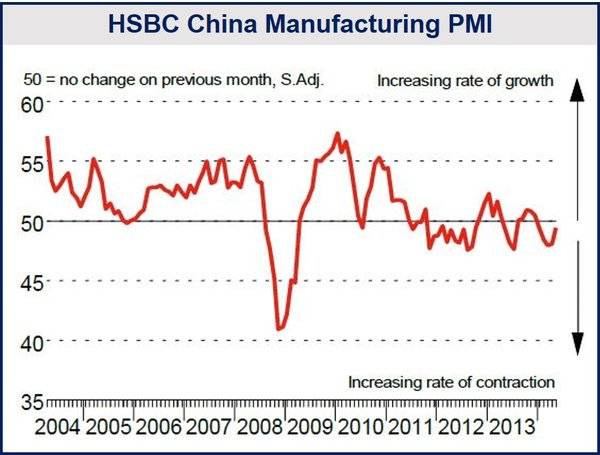Fears of a steep slowdown in GDP growth may have been allayed after both Chinese PMIs for May (services and manufacturing) were published. China’s non-manufacturing PMI (services) rose to 55.5 in May compared to 54.8 in April, while its Manufacturing PMI improved slightly to 49.4 versus April’s 48.1.
PMI stands for ‘Purchasing Managers’ Index’, any reading above 50 suggests the sector is expanding. The Chinese service sector makes up almost 43% of the country’s GDP and includes aviation and construction.
Manufacturing – new orders stabilizing
According to May’s data, operating conditions in China’s manufacturing sector deteriorated only slightly, with new orders stabilizing after declining for three straight months.
According to the HSBC Purchasing Managers’ Index for manufacturing, which was compiled by Markit, relatively weak market conditions were caused mainly by subdued client demand, while new export orders grew at their fastest pace in more than four years.
The report authors say that some Chinese companies lowered production because of uncertain economic conditions. Total new business remained unchanged in May, after three successive months of decline.
According to the report “Data suggested that muted domestic demand hindered overall new work wins, as new export orders rose at the fastest rate since April 2010.”
Manufacturing employment decline
Manufacturing company down-sizing policies were the main cause of the employment decline, which has been sliding since November. Even though fewer people work in the sector now compared to six months ago backlogs of work fell.
Over the last five months, average cost burdens have fallen, though the rate of decline was weakest in May, while output charges rose last month for the first time this year, with some manufacturers commenting that stronger demand conditions boosted pricing power.
Hongbin Qu, Chief Economist, China & Co-Head of Asian Economic Research at HSBC, made the following comment on the China Manufacturing PMI survey:
“The final HSBC China Manufacturing PMI rebounded to 49.4 in May, up from 48.1 in April, and revised down slightly from the earlier flash reading of 49.7. New orders stabilized, while new export orders recorded an impressive expansion of 53.2. But growth momentum looked weaker than suggested in the flash reading as the stocks of finished goods index was revised up to 49.8 from 48.8 in the flash reading.”
“The final PMI reading for May confirmed that the economy is stabilizing, but it is too early to say that it has bottomed out, particularly in light of a weaker property sector. The lack of a sustainable growth momentum warrants stronger policy support. We expect both monetary and fiscal policy to be loosened gradually over the coming months.”
Slower Q1 2014 GDP growth
China’s GDP grew by 7.4% in the first quarter of 2014, according to data published by the National Bureau of Statistics (NBS), compared to 7.7% in Q4 2013. Figures were better than experts had predicted.
Year-on-year (March 2014 vs. March 2013), factory output increased by 8.8%, retail sales rose 12.2%, and fixed asset investment grew by 17.6%.
The NBS said Q1 2014 GDP growth was slower because of domestic economic structural reforms, a slower-than-expected economic rebound, and the Lunar New Year.
(Source: HSBC)
Mixed Chinese economic data
Last week, The Conference Board reported a better economic outlook for China, although overall the economy looks weaker than it did last year.
Resident economist, Andrew Polk, said:
“The LEI (Leading Economic Index) for China increased in April, but its overall expansion remains weaker than the latter half of 2013 and underlying volatility in the economy has increased.”
“Subdued LEI growth, combined with growth rates in industrial activity and retail sales running at their lowest since 2004, suggest that the slower trend of economic growth will continue into the third quarter at least.”
However, there is growing concern about China’s housing slowdown. The number of major cities reporting higher home prices in April fell to its lowest level in 18 months as developers started offering knock-down prices to attract buyers.

